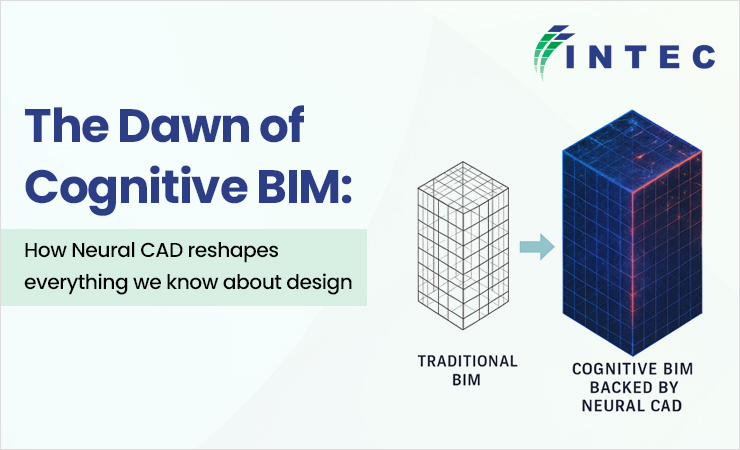Blog

- 25 September 2025
- Predict Needs: The model can anticipate potential issues, such as clash occurrences in the design, cost overruns that can topple the budget off-guard, and even highlight safety risks.
- Suggest Solutions: The system can not only flag issues but can also actively suggest solutions.
- Learn & Adapt Faster: A full-fledged cognitive BIM system can learn from past projects, adapt to a company's unique design standards and workflows, and help to elevate the future project’s performance and quality.
Autodesk’s latest release of Neural CAD at the Autodesk University 2025 (AU 2025), unveiled a new category of 3D generative AI foundation models. These models for Fusion and Forma are more than just new software features. These are the foundational steps to Cognitive BIM - a paradigm shift where AI leads the change and takes cognitive computing beyond the traditional Building Information Modeling (BIM) process.
How? Let’s take a deep dive to know more.
What is Cognitive BIM and how does Neural CAD play a pivotal role?
Cognitive BIM is an overarching concept that converges BIM & AI’s vast capabilities to learn, reason, adapt, predict, and respond with an unimaginable level of intelligence. Think of Traditional BIM as a blueprint, which is precise, but passive, record of a building. You can view it to detect clashes and keep it for documentation; however, it would require constant manual input and oversight.
With Neural CAD stepping in, it allows the model to:
Traditional BIM v/s Cognitive BIM backed by Neural CAD
| Feature | Traditional BIM | Cognitive BIM with Neural CAD |
|---|---|---|
| Core Principle | Traditional BIM processes use data-rich, centralized 3D model. It digitizes the design and construction workflow. | Cognitive BIM is an intelligent, generative design process that utilizes AI to automate and take the traditional BIM workflows a step ahead. |
| Design Approach | Designers manually create and place objects like walls, windows, etc. and assign data to them. | It generates design options from high-level inputs like text descriptions, sketches, or images; even automates repetitive tasks. |
| Speed & Efficiency | It is faster than 2D CAD and can even automate clash detection and information management. | This transforms the entire process drastically by reducing the design time. It helps to automate complex, repetitive tasks e.g., generating layouts, optimizing structures etc. |
| Input Method | Traditional BIM primarily uses a graphical user interface (GUI), mouse, and keyboard to draw and model. | Cognitive BIM can accept inputs from various sources such as natural language prompts, freehand sketches, and images. |
| Design Iteration | Requires manual adjustments and updates for each design change. | Enables rapid, large-scale generation and exploration of design alternatives. |
| Role of the Professional | Role required here is of a modeler, data manager, and collaborator. He/she is in full control of all inputs and changes. | One would require a strategist, prompter, and curator. He/she will guide the AI, define objectives, and select the best options from a wide range of possibilities. |
| Technology Base | Relies on parametric and object-oriented modeling software e.g., Revit, Tekla, etc. | Backed by generative AI models (Neural CAD) and machine learning algorithms. |
Cognitive BIM is different from traditional BIM as it adds an intelligent layer to the blueprint. When we talk about the traditional BIM process, it has always remained a reactive process, i.e. designer conceptualizes and then models. However, Neural CAD breaks this linearity, making cognitive BIM a dynamic canvas. It helps in:
1. Designing For Innovation - Minus the Mundane
Neural CAD has brought a transformation to how manual CAD was operated over the past 40 years. Today, a designer can provide a natural language prompt – “Change building shape” and the system will instantly recompute everything from walls to columns, to platforms, grid lines, and even the structural drawings, leveraging its deep understanding of engineering and architectural principles.
Not only this, but firms can evaluate multiple design options in a matter of days rather than weeks.
This would not only help to elevate design and power innovation but would also enable far more informed client engagement right from the start.2. Intelligent Detailing and Documentation:
Cognitive BIM powered by Neural CAD can not only automate documentation, scheduling, etc., but can also play a huge role in complex problem-solving. Imagine AI proactively performing load analysis and suggesting the right rebar layouts or generating reports highlighting complex connections. This strategic optimization and intelligent validation can free BIM engineers and help them focus on high-value tasks that take up a huge amount of time otherwise.
Challenges that revolve around Neural CAD & Cognitive BIM:
While AI does bring us closer to BIM excellence, there are many hurdles to tackle still. Firms must ensure ethical data usage and protect proprietary information, especially when it comes to AI. Likewise, we cannot simply accept what AI-generated output suggests right away without human scrutiny. Engineers & design guardians still need to ensure their impact is in line with integrity, quality, and ethical considerations.
How does the future of Cognitive BIM look like with Neural CAD?
From helping designers in beginning a project with a prompt to generating full-scale, data-rich BIM models, the future does look promising. This newer, proactive model can even be integrated with other technologies, such as IoT & robotics, to incorporate real-time sensor data and learn, optimize, and predict powerful insights that prove to be crucial in shaping the entire design and BIM landscape. While adoption might be slower, Intec believes it would lend a competitive edge to firms that do.
